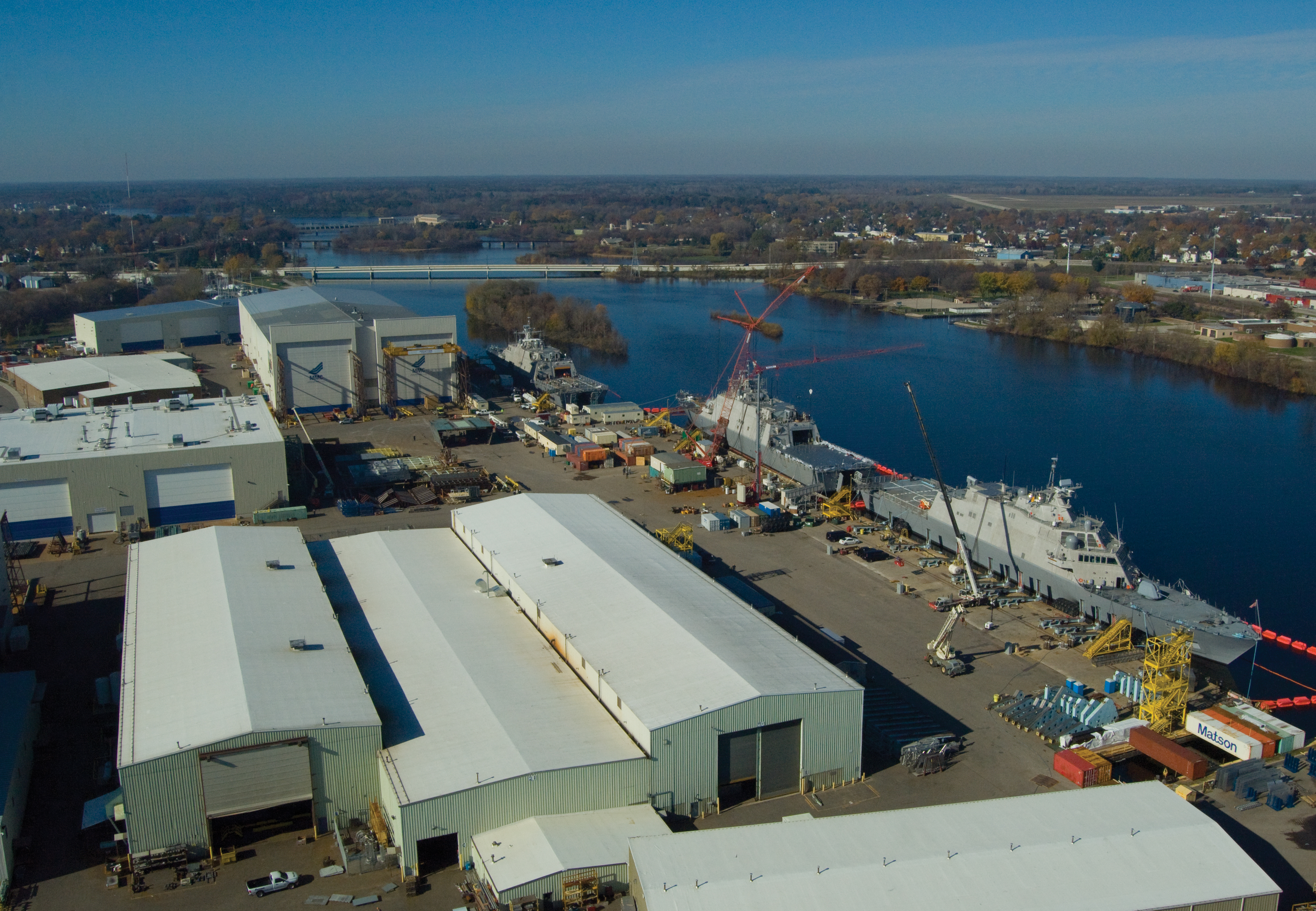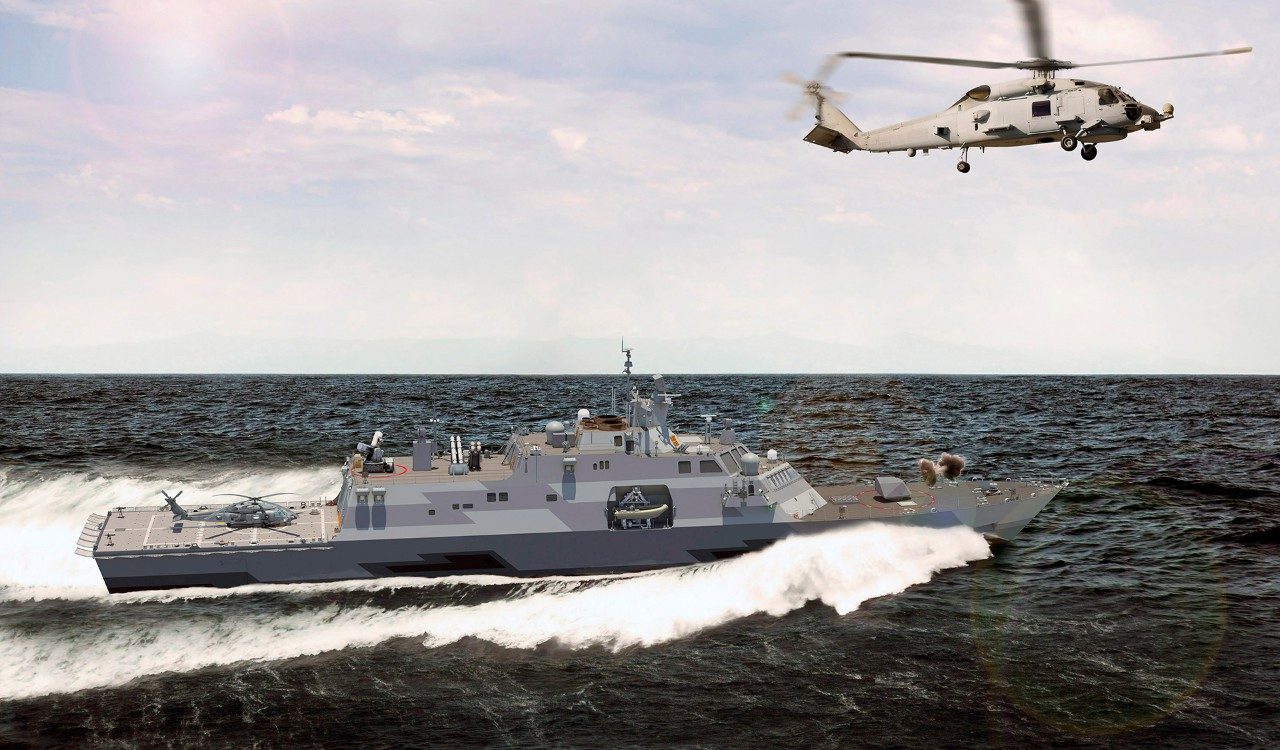Saudis Save Wisconsin Shipbuilder: Fills Gap Between LCS & Frigates At Marinette
Posted on

The Marinette Marine Corp. shipyard in Wisconsin, with three Freedom-class Littoral Combat Ships in view.
WASHINGTON: Four years after Lockheed Martin inked a $11.2 billion deal to sell Saudi Arabia an upgunned variant of its Littoral Combat Ship, the company is starting work on the first vessel later this year, a company official confirmed Wednesday.
The work on four Multi-Mission Surface Combatants will take place at Fincantieri-owned Marinette Marine in Wisconsin, The timing’s perfect because Marinette yard is just starting work on the last LCS funded by Congress, whose final contract was awarded just this week. Company officials hope the Saudi work is the bridge to keep the yard humming until it wins the Navy’s hotly contested frigate program — for which Lockheed and Marinette are offering, in essence, a souped-up LCS similar to the Saudi variant.
The Saudi ship deal was included in President Trump‘s boast that he closed on $110 billion worth of weapons sales to the kingdom in the early days of his presidency. The vast majority of those potential contracts were signed during the Obama administration, and most have not yet materialized.

Lockheed Martin’s Multi-Mission Surface Combatant, slated to be sold to Saudi Arabia.
“We currently working through the design integration,” Lockheed Martin’s Joe DiPietro, vice president of small combatants, told me. The first ship is targeted to move to start production towards the end of 2019. The ships are being designed to be interoperable with both the US Navy and Saudi Arabia’s French-built legacy fleet, along with plenty of offensive punch.
The ships will feature an eight-cell Mk-41 Vertical Launch System. The original LCS doesn’t have this powerful multi-purpose weapon, standard on US cruisers and destroyers, but after much debate the Navy made VLS mandatory for the frigate. Figuring out how to install the bulky tubes was a major challenge for both Marinette and rival LCS builder Austal — which makes a trimaran variant nicknamed the Klingon Bird of Prey — as they positioned themselves for the frigate competition.
Saudi Arabia has also purchased over 500 Raytheon RIM-162 Evolved Sea Sparrow Missiles (ESSMs) to fit into the VLS tubes. The ESSM is a relatively short-ranged defensive weapon meant to shoot down incoming aircraft and enemy ship-killing missiles, but the plug-and-play design of the VLS means it can accommodate longer-ranged Standard Missiles for missile defense and a wide range of offensive weapons as well, from the traditional Tomahawk to Lockheed’s new Long-Range Anti-Ship Missile (LRASM).
Stayin’ Alive
The Saudi work keeps the Wisconsin shipyard busy just as the company’s Littoral Combat Ship work was running dry with the truncation of the always controversial LCS program.
In 2017 through 2019, the Marinette yard was awarded one LCS per year, In 2018, the company laid two keels, launched two ships, delivered two ships and completed three acceptance trials. “Now,” DiPietro told me, “we’re on a path where last year we delivered two ships, we trialed two ships, we started construction on two more — and now when you’re seeing where it looks like the curve is starting to dip, MMSC starts production.”
The Saudi contract calls for one ship in 2019, two in 2020, and one in 2021, DiPietro said: “It’s a great gap filler as we wait to see what plays out with FFG(X),” the Navy’s new frigate. That program is slated to begin production around 2022 or ‘23.
The future frigate is meant to pick up where the curtailed LCS program is leaving off. While the LCS was invented in an era of US naval dominance and optimized for lower-threat missions, the US and its NATO allies are now urgently refocusing on major war — especially as they rush to rebuild the submarine-hunting skills they allowed to atrophy after the Cold War. Russian activity in the North Atlantic and burgeoning Chinese capabilities in the Pacific are leading the Navy to look to build a new class of frigates with towed arrays and other technologies that can track stealthy subs, as well as VLS to shoot down incoming missiles and attack enemy ships.
The concept design phase for the FFG(X) is slated to go through June, with an award late this year.
But the newly-minted chairman of the House Armed Services seapower and projection forces subcommittee, Rep. Joe Courtney, expressed frustration with the program on Wednesday.
Speaking at the 2019 Surface Navy Association Symposium, Courtney said that work needs to happen faster, so whoever wins the award can get their shipyard up and running, with no gaps between programs. “I understand the importance to these yards to try to maintain the industrial base, but we really need to get moving in terms of the frigate program,” Courtney said. “If there’s going to be another request for a delay, it is going to be frankly a bit of a headache for us this year.”
The Navy plans to make an award in the program in 2019, and several competitors have put forward mature designs. Besides Marinette and Austal upgrading their respective variants of LCS, General Dynamics’ Bath Iron Works is partnering with Navantia to offer Spain’s Álvaro de Bazán-class F100 frigate; Italian shipbuilder Fincantieri the Italo-French FREMM Multimission Frigate; and Huntington Ingalls Industries has released artists’ renderings of what it might compete, such as a militarized variant of its Coast Guard National Security Cutter. Each company was awarded $15 million contracts to provide the Navy with designs. The Navy plans to buy 20 frigates starting in 2020.
Sydney Freedberg contributed to this article.
Subscribe to our newsletter
Promotions, new products and sales. Directly to your inbox.


